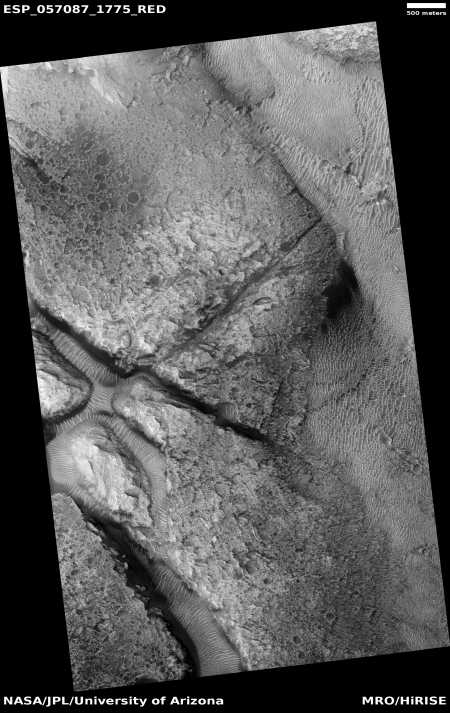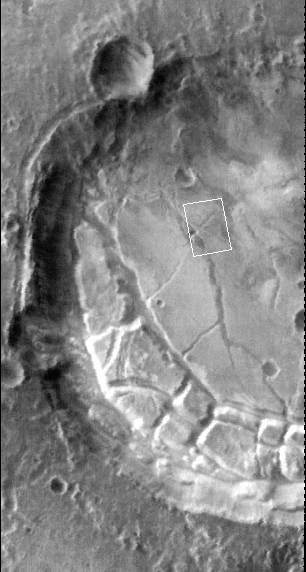Puzzling fractures on Mars
Cool image time! Today the Mars Reconnaissance Orbiter (MRO) science team released another month’s worth of images from the spacecraft’s high resolution camera. The picture on the right, reduced in resolution to post here, was the first image that I took a close look at, and decided it was worth posting immediately. If you click on the image you can see the full resolution version.
This image lacks a caption, but the release webpage is titled “Fractured Crater Floor.” It shows several cross-crossing fissures, some wide enough for dust to gather within into sand dunes. The fractures themselves appear to be cutting across a bulging dome.
My first reaction was to wonder where the heck this crater was on Mars, how big was it, and how dominate were the fractures within its floor. The image itself does not answer any of these questions. The fractures could be filling the floor, or not, and the crater could be small or big. Moreover, its location might help explain the cause of the fractures.
To understand any of the images from MRO it is always important to zoom out to get some context.

The white cross on the overview image to the right shows the location of this crater, to the east of Marineris Valles on the high southern plateau that forms much of the planet’s southern hemisphere.
The crater itself is actually somewhat large. The photograph on the right, cropped, reduced, and annotated to post here, was taken by different camera on MRO, and shows the entire western half of the crater. If you click on the image you can see the full photograph. The white box indicates the approximate location of the fractures in the image above. From this image it looks as if the crater’s floor actually bulged upward post impact, causing the fractures as the pressure pushed up from below.
MRO has taken a lot of images of this crater’s floor. It appears the planetary scientists are intrigued by these fractures, and possibly are wondering if they and the bulging crater floor are evidence of later volcanic activity. This is made even more intriguing in that few other large craters in this region have the same type features. Why should this particular crater look so uniquely different?
The area to the east of this crater generally appears featureless, but MRO scientists have taken a lot of images in that area as well. My first thought was this area might have been considered a candidate landing site for one of the landers or orbiters either on their way or soon to be launched to Mars. I did some quick checking however and was unable to confirm this.
On Christmas Eve 1968 three Americans became the first humans to visit another world. What they did to celebrate was unexpected and profound, and will be remembered throughout all human history. Genesis: the Story of Apollo 8, Robert Zimmerman's classic history of humanity's first journey to another world, tells that story, and it is now available as both an ebook and an audiobook, both with a foreword by Valerie Anders and a new introduction by Robert Zimmerman.
The print edition can be purchased at Amazon or from any other book seller. If you want an autographed copy the price is $60 for the hardback and $45 for the paperback, plus $8 shipping for each. Go here for purchasing details. The ebook is available everywhere for $5.99 (before discount) at amazon, or direct from my ebook publisher, ebookit. If you buy it from ebookit you don't support the big tech companies and the author gets a bigger cut much sooner.
The audiobook is also available at all these vendors, and is also free with a 30-day trial membership to Audible.
"Not simply about one mission, [Genesis] is also the history of America's quest for the moon... Zimmerman has done a masterful job of tying disparate events together into a solid account of one of America's greatest human triumphs."--San Antonio Express-News
Cool image time! Today the Mars Reconnaissance Orbiter (MRO) science team released another month’s worth of images from the spacecraft’s high resolution camera. The picture on the right, reduced in resolution to post here, was the first image that I took a close look at, and decided it was worth posting immediately. If you click on the image you can see the full resolution version.
This image lacks a caption, but the release webpage is titled “Fractured Crater Floor.” It shows several cross-crossing fissures, some wide enough for dust to gather within into sand dunes. The fractures themselves appear to be cutting across a bulging dome.
My first reaction was to wonder where the heck this crater was on Mars, how big was it, and how dominate were the fractures within its floor. The image itself does not answer any of these questions. The fractures could be filling the floor, or not, and the crater could be small or big. Moreover, its location might help explain the cause of the fractures.
To understand any of the images from MRO it is always important to zoom out to get some context.

The white cross on the overview image to the right shows the location of this crater, to the east of Marineris Valles on the high southern plateau that forms much of the planet’s southern hemisphere.
The crater itself is actually somewhat large. The photograph on the right, cropped, reduced, and annotated to post here, was taken by different camera on MRO, and shows the entire western half of the crater. If you click on the image you can see the full photograph. The white box indicates the approximate location of the fractures in the image above. From this image it looks as if the crater’s floor actually bulged upward post impact, causing the fractures as the pressure pushed up from below.
MRO has taken a lot of images of this crater’s floor. It appears the planetary scientists are intrigued by these fractures, and possibly are wondering if they and the bulging crater floor are evidence of later volcanic activity. This is made even more intriguing in that few other large craters in this region have the same type features. Why should this particular crater look so uniquely different?
The area to the east of this crater generally appears featureless, but MRO scientists have taken a lot of images in that area as well. My first thought was this area might have been considered a candidate landing site for one of the landers or orbiters either on their way or soon to be launched to Mars. I did some quick checking however and was unable to confirm this.
On Christmas Eve 1968 three Americans became the first humans to visit another world. What they did to celebrate was unexpected and profound, and will be remembered throughout all human history. Genesis: the Story of Apollo 8, Robert Zimmerman's classic history of humanity's first journey to another world, tells that story, and it is now available as both an ebook and an audiobook, both with a foreword by Valerie Anders and a new introduction by Robert Zimmerman.
The print edition can be purchased at Amazon or from any other book seller. If you want an autographed copy the price is $60 for the hardback and $45 for the paperback, plus $8 shipping for each. Go here for purchasing details. The ebook is available everywhere for $5.99 (before discount) at amazon, or direct from my ebook publisher, ebookit. If you buy it from ebookit you don't support the big tech companies and the author gets a bigger cut much sooner.
The audiobook is also available at all these vendors, and is also free with a 30-day trial membership to Audible.
"Not simply about one mission, [Genesis] is also the history of America's quest for the moon... Zimmerman has done a masterful job of tying disparate events together into a solid account of one of America's greatest human triumphs."--San Antonio Express-News




I blame anthropogenic climate change.
Every time I see those red squares I am torn between targeted imagery for immediate benefits and an OCD compulsion for a systematic survey that starts in one spot and images everything in the most efficient way that is quicker over time but not as useful in the short term. It is really a shame we don’t already have a constellation of satellites at Mars by now. Hopefully, this will all change soon.
Yes, Floor Fractured Craters are formed when magma upwells through impact induced fractures. Not enough magma to completely flood the crater. But still enough to more or less cause the floor to float, fracture and spread out.
https://sciencetrends.com/lunar-floor-fractured-craters-provide-evidence-for-ancient-magmatic-intrusions/